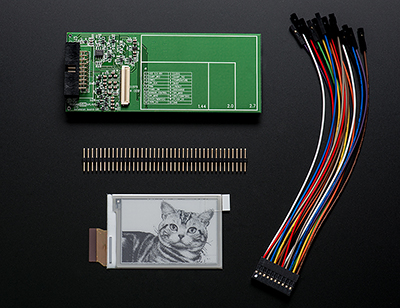|
Ever since the Kindle eReader came out, we've been wanting a nice small graphical eInk display that is easy to use with a microcontroller. And finally our desires have been fulfilled with the rePaper 2.7" development board from Pervasive Displays! We're excited to offer this very interesting display breakout for hackers who want to start playing with small eInk displays.
This kit comes with a driver board that is powered from 3V and has level shifting on all the I/O pins so it can be used with 5V microcontrollers such as the Arduino. The PCB also has a lot of driver circuitry required to keep the display running smoothly such a temperature sensor, FLASH memory and ZIF socket. All signals are broken out to a 20 male socket header on the left. A 20 pin socket/socket cable is included to make wiring easier and there's also some extra-long header so you can plug these wires into Arduino header or a breadboard.
The display is 2.7" diagonal and 264 x 176 resolution true eInk graphical display. These are intended for use as small dynamic signage in grocery stores since a barcode displayed on it can be scanned by a laser barcode-reader. The display does not require any power to keep the image and will stay 'on' without any power connection for many days before slowly fading. Of course, its also daylight readable and is very high contrast. This makes it excellent for data-logging applications, outdoor displays, or any other ultra-low power usages

The good news is that rePaper/PDI have provided a suite of example code for Arduino UNO/Leonardo as well as the MSP430 Launchpad and also have a site with some documentation on how to wire up the displays and datasheets. However, please note: the displays are quite large pixel-wise and to dynamically write to the display requires 3K of RAM - more than the Arduino Uno or Leo/Launchpad so for those boards, the example code only displays what is stored in a 8-pin FLASH chip in the devboard. (By default that FLASH contains a picture of a cat and some imaged text, see photos above)
At this time, neither the Arduino UNO or Mega can use the GFX-library for a display of this size. Adafruit will try to fix PDI's code to support the Mega, but there's no ETA.
Documents:
|








